Search
Did you mean: Copan?
Search Results

Definition
Tokugawa Tsunayoshi
Tokugawa Tsunayoshi (1646-1709) governed Japan as the fifth shogun of the Edo period (1603-1876). He has often been ridiculed as the 'dog shogun' because of the laws he enacted to protect the lives of animals. Economically, however, the period...
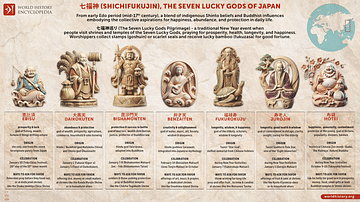
Image
The Seven Lucky Gods of Japan
An infographic about Shichifukujin, or the Seven Lucky Gods (Seven Gods of Fortune) of Japan, a revered group of deities associated with prosperity and good fortune. Each god represents different blessings, including wealth, happiness, and...
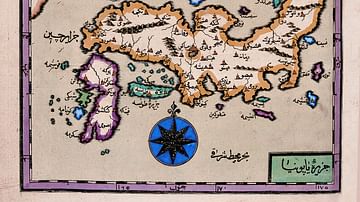
Image
Map of Japan by Katip Çelebi
Map of Japan by Katip Çelebi (d. 1657), geographer of the Ottoman Empire, in his famous geographic dictionary, Kitab-ı Cihannüma (View of the World).
Cambridge University Library.
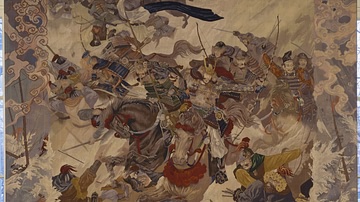
Image
The Mongol Invasion of Japan
"The Mongol Invasion" is a Japanese silk tapestry by Kawashima Jimbei II (Japanese, 1853 - 1910 CE), based on an oil painting by Morizumo Yugyo (1854 - 1927 CE). The painting depicts the Mongol Empire's failed invasions of Japan in in 1274...

Definition
Tokugawa Ieyasu
Tokugawa Ieyasu (1543-1616) was a Japanese military leader who reunified Japan at the beginning of the 17th century after a long period of civil war, known as the Warring States or Sengoku period. He created a new government controlled by...
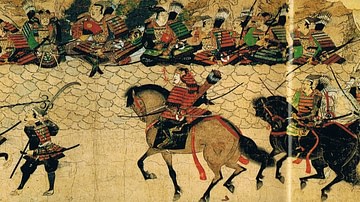
Image
Mongol Invasion of Japan, 1281 CE
A detail showing the failed Mongol attack on the defensive walls of Hakata, Japan in 1281 CE. From the Mongol Scroll, aka the 'Illustrated Account of the Mongol Invasion of Japan.' Commissioned by Takezaki Suenaga, 1293 CE.

Image
Agata Shrine in Uji, Japan
The Agata were tribal units under the reign of the Yamato court (c. 300-650 CE), which held sway over western Japan. Particularly in the Nara and Kyoto areas, the agata played important political and ceremonial roles. The name of the Agata...
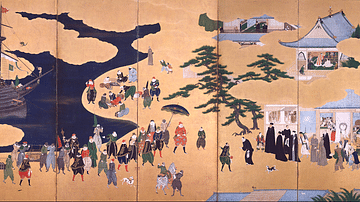
Image
The Portuguese in Japan
A Japanese painted screen by Kanō Naizen showing a Portuguese carrack ship and traders. The Portuguese controlled the trading port of Nagasaki from c. 1571 to 1639. (Kobe City Museum, Japan)

Image
A Composite Imaginary View of Japan
A large silk embroidered wall hanging, worked in long and short silk stitch, with a composite imaginary view of Japan, including shrines, bridges, lakes, forests and flowers, Mount Fuji rising in the distance, within a brocade border. Khalili...

Image
Whale Bone Spade from Ancient Japan
This whale bone spade comes from Japan and dates from the Jomon period, between the 2nd-1st century BCE. (Tokyo National Museum)